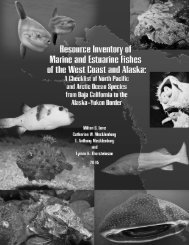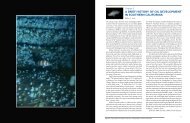Reproductive Ecology and Body Burden of Resident ... - The Love Lab
Reproductive Ecology and Body Burden of Resident ... - The Love Lab
Reproductive Ecology and Body Burden of Resident ... - The Love Lab
Create successful ePaper yourself
Turn your PDF publications into a flip-book with our unique Google optimized e-Paper software.
Results<br />
Within Pacific s<strong>and</strong>dab ovaries, we observed (1) hydrated eggs, (2) smaller eggs with yolks that<br />
would later grow <strong>and</strong> hydrate prior to spawning, (3) postovulatory follicles, (4) minor atresia, <strong>and</strong> (5) pronounced<br />
atresia (Figures. 2A-C, Table 2).<br />
Egg hydration (Figure 2A) occurs just prior to spawning, when a mature oocyte exp<strong>and</strong>s to as much<br />
as four times its original volume (Wallace <strong>and</strong> Selman, 1981). Between 100% (Platform Gilda) <strong>and</strong> 50%<br />
(Rincon) <strong>of</strong> fish at each site contained hydrated eggs (Table 2). Smaller yolked eggs were found in between<br />
100% (Platform Gilda) <strong>and</strong> 55% (Rincon) <strong>of</strong> fish (Table 2). Postovulatory follicles (Figure 2B) are remnants<br />
<strong>of</strong> the granulosa layer <strong>of</strong> the previously spawned egg that hypertrophies after the oocyte is released <strong>and</strong> thus<br />
their presence demonstrates that a female has spawned earlier in the season. Older postovulatory follicles (><br />
24 hours) can be distinguished from “fresh” ones by deterioration <strong>of</strong> original shape <strong>and</strong> loss <strong>of</strong> organization.<br />
<strong>The</strong> presence <strong>of</strong> postovulatory follicles from a recent spawning alongside maturing follicles destined for a<br />
subsequent spawning (Figure 2B) indicates Pacific s<strong>and</strong>dab spawn more than once during a reproductive<br />
season. Postovulatory follicles were found in between 65% (Santa Cruz Isl<strong>and</strong>) <strong>and</strong> 5% (Rincon) <strong>of</strong> fish<br />
(Table 2). At least some fish with minor atresia (Figure 2C) were noted at all <strong>of</strong> the sites, with levels ranging<br />
from 60% (Platform Gilda) to 15% at Santa Cruz Isl<strong>and</strong>. Pronounced atresia was relatively rare. No<br />
fish at Platform Gilda <strong>and</strong> Santa Cruz Isl<strong>and</strong> were identified as having pronounced atresia, while 6% <strong>of</strong> the<br />
s<strong>and</strong>dabs at Platform B <strong>and</strong> 16% at Rincon exhibited this condition (Table 2).<br />
Table 2. Histological analyses <strong>of</strong> Pacific s<strong>and</strong>dab ovaries from four sites in the Santa Barbara. Values in each column are in percentages.<br />
Site<br />
n<br />
Hydrated<br />
Eggs<br />
Yolk in Smaller<br />
Modes<br />
Post-ovulatory<br />
Follicles<br />
Minor<br />
Atresia<br />
Pronounced<br />
Atresia<br />
B 18 95 95 61 22 6<br />
Rincon 19 50 55 5 35 16<br />
Gilda 20 100 100 35 60 0<br />
SCI 21 85 85 65 15 0<br />
74




